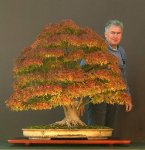ColinFraser
Masterpiece
Cool; I wish we could grow larch in this climate - that's the only thing that makes living in a cold place even remotely appealing to meSo browsed thru this thread and diddnt see many examples. I guess Ill go out on a limb here. This is a larch I collected a couple years ago. cut back once at collection and once a couple weeks ago. Lots of bar branches =not perfect, not very thick trunk for a 24 inch tree=not perfect, some flaky bark not enough to be perfect, and the slightest hint of taper.View attachment 142080but it was the perfect tree to dig with plenty of good enough attributes. Anyone that knows larch knows theyr straight poles with no taper, so maybe not perfect, but perfectly nautraulistic in shape, size , and a perfectly good start to train as a future bonsai. Soooooooo it may not meet certain standards to be perfect. But it was the perfect tree to dig that day, and the perfect tree to pursue a training plan for. I plan on wiring in 2018, but until then it seems pretty perfect for my level and goals to make something out of what was already almost perfect. Thoughts?
Since we (almost) all agree that criticism can be constructive, and that criticism of a tree is not necessarily criticism of its owner, I'll proffer a thought per your request.
Branch Thickness - it appears that the thickest branch on this tree is near the upper right (though it's hard to tell for sure from the photo). At the minimum, the lower branches aren't any thicker than the upper ones. This is something to keep in mind as you begin to develop the tree. Since I can't grow these, I can't offer specific horticultural advice, so this is only aesthetic commentary, but growing out the lower branches while keeping the top ones in check might be the next step . . .
Edit: Oh, also, I've said it before and I'll say it again, shorter branches are a good way to go on a tall skinny trunk - pulling and pruning them in tight near the trunk (in the long run) will often really improve the image.


